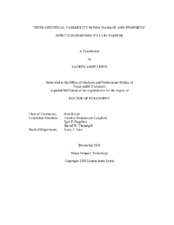| dc.description.abstract | Exposure to environmental and occupational chemicals can result in human disease which may be driven by genotoxicity and epigenetic alterations. In addition, genetic variants and sex-specific differences in epigenetic modifications and DNA damage may also influence chemical-induced adverse health effects. Our overall objective is to investigate interindividual variability in epigenetic alterations and DNA damage in response to 1,3- butadiene, a model genotoxic carcinogen and industrial toxicant. Although genotoxicity is an established mechanism of 1,3-butadiene carcinogenesis, epigenetic effects such as DNA methylation and histone modifications have also been reported. Importantly, interstrain differences exist in both 1,3-butadiene-induced DNA damage and epigenetic effects in mice. Recent studies indicate that the variation in epigenetic alterations may be a key driver of the inter-individual susceptibility to 1,3-butadiene genotoxicity. First, we characterized inter-individual differences in 1,3-butadiene-induced DNA damage and epigenetic effects using a population-based model of Collaborative Cross mouse strains. We observed strain- and tissue-dependent variability of 1,3-butadiene-induced epigenetic alterations which may influence individual and organ susceptibility to carcinogenesis. Genetic mapping identified several candidate genes that may play a role in individual differences in global histone modifications. Second, we investigated sex-specific effects in response to 1,3-butadiene. Strain- and tissue-specific differences in DNA damage and global epigenetic alterations were detected. Third, we evaluated the expression of microRNA in order to better understand the mechanisms by which 1,3-butadiene alters the epigenome as well as the transcriptome.
We observed strain- and tissue-specific expression profiles of microRNA. Furthermore, we identified microRNA as candidate master regulators of differential gene expression across strains and tissues. Overall, our work contributes to a better understanding of inter-individual variability in response to chemical exposure which is a critical need in hazard and risk assessment. | en |


